Effectiveness of Actions for Environment Protection: A Critical Review
VerifiedAdded on 2023/06/11
|10
|1821
|50
Essay
AI Summary
This essay critically evaluates the effectiveness of actions taken by governments and organizations to protect the environment, focusing on air pollution and deforestation. It argues that despite numerous plans and policies, practical solutions have yielded minimal results due to governments' conflicting political and economic motives, and organizations' failures to address the specific needs of different regions. The essay highlights instances where governmental actions, such as China's Air Pollution Prevention and Control Action Plan, have shown localized success, while others, like Nigeria's response to soot pollution, have been delayed and ineffective. It also addresses the role of corporations, both positively through Corporate Social Responsibility (CSR) initiatives and negatively through environmental scandals like Volkswagen's emissions scandal. Deforestation is examined in the context of industrialization and economic gain, with examples of both governmental efforts to protect forests, such as Brazil's Forest Code, and the involvement of corporations like Starbucks and McDonald's in deforestation. The essay concludes that international laws and policies are not adequately followed, and increased attention, awareness, and tailored research are needed to address air pollution and deforestation effectively. Desklib provides access to similar essays and study tools for students.
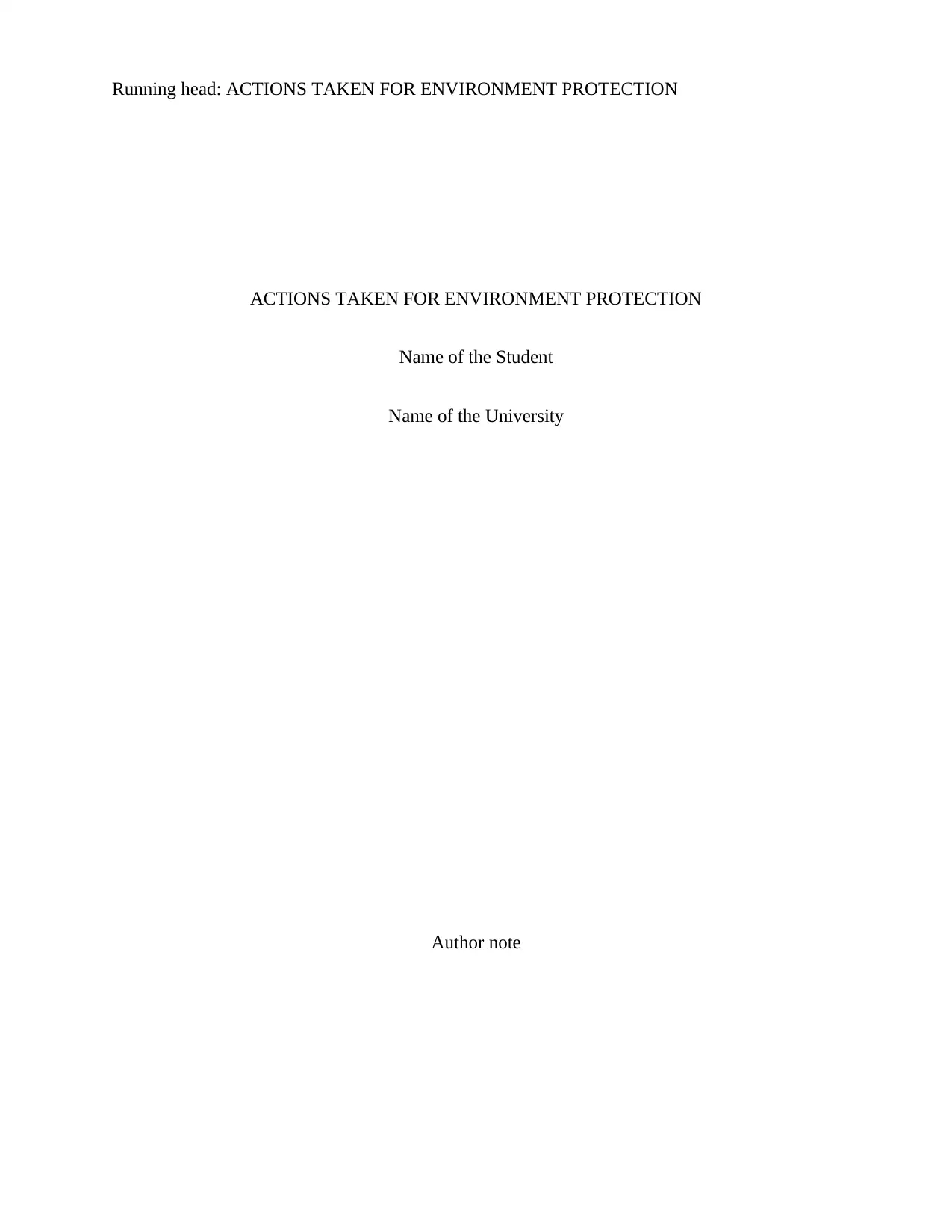
Running head: ACTIONS TAKEN FOR ENVIRONMENT PROTECTION
ACTIONS TAKEN FOR ENVIRONMENT PROTECTION
Name of the Student
Name of the University
Author note
ACTIONS TAKEN FOR ENVIRONMENT PROTECTION
Name of the Student
Name of the University
Author note
Paraphrase This Document
Need a fresh take? Get an instant paraphrase of this document with our AI Paraphraser
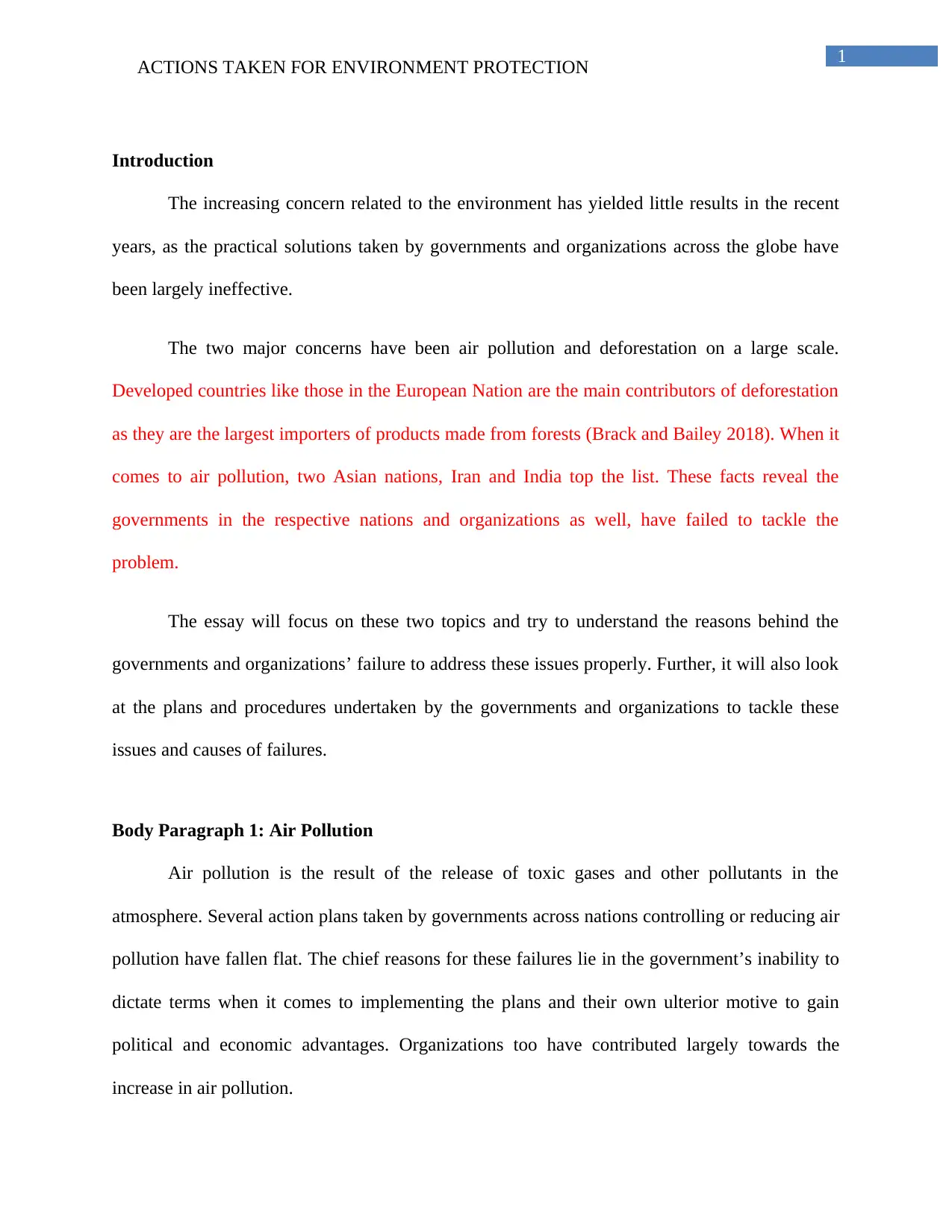
1
ACTIONS TAKEN FOR ENVIRONMENT PROTECTION
Introduction
The increasing concern related to the environment has yielded little results in the recent
years, as the practical solutions taken by governments and organizations across the globe have
been largely ineffective.
The two major concerns have been air pollution and deforestation on a large scale.
Developed countries like those in the European Nation are the main contributors of deforestation
as they are the largest importers of products made from forests (Brack and Bailey 2018). When it
comes to air pollution, two Asian nations, Iran and India top the list. These facts reveal the
governments in the respective nations and organizations as well, have failed to tackle the
problem.
The essay will focus on these two topics and try to understand the reasons behind the
governments and organizations’ failure to address these issues properly. Further, it will also look
at the plans and procedures undertaken by the governments and organizations to tackle these
issues and causes of failures.
Body Paragraph 1: Air Pollution
Air pollution is the result of the release of toxic gases and other pollutants in the
atmosphere. Several action plans taken by governments across nations controlling or reducing air
pollution have fallen flat. The chief reasons for these failures lie in the government’s inability to
dictate terms when it comes to implementing the plans and their own ulterior motive to gain
political and economic advantages. Organizations too have contributed largely towards the
increase in air pollution.
ACTIONS TAKEN FOR ENVIRONMENT PROTECTION
Introduction
The increasing concern related to the environment has yielded little results in the recent
years, as the practical solutions taken by governments and organizations across the globe have
been largely ineffective.
The two major concerns have been air pollution and deforestation on a large scale.
Developed countries like those in the European Nation are the main contributors of deforestation
as they are the largest importers of products made from forests (Brack and Bailey 2018). When it
comes to air pollution, two Asian nations, Iran and India top the list. These facts reveal the
governments in the respective nations and organizations as well, have failed to tackle the
problem.
The essay will focus on these two topics and try to understand the reasons behind the
governments and organizations’ failure to address these issues properly. Further, it will also look
at the plans and procedures undertaken by the governments and organizations to tackle these
issues and causes of failures.
Body Paragraph 1: Air Pollution
Air pollution is the result of the release of toxic gases and other pollutants in the
atmosphere. Several action plans taken by governments across nations controlling or reducing air
pollution have fallen flat. The chief reasons for these failures lie in the government’s inability to
dictate terms when it comes to implementing the plans and their own ulterior motive to gain
political and economic advantages. Organizations too have contributed largely towards the
increase in air pollution.
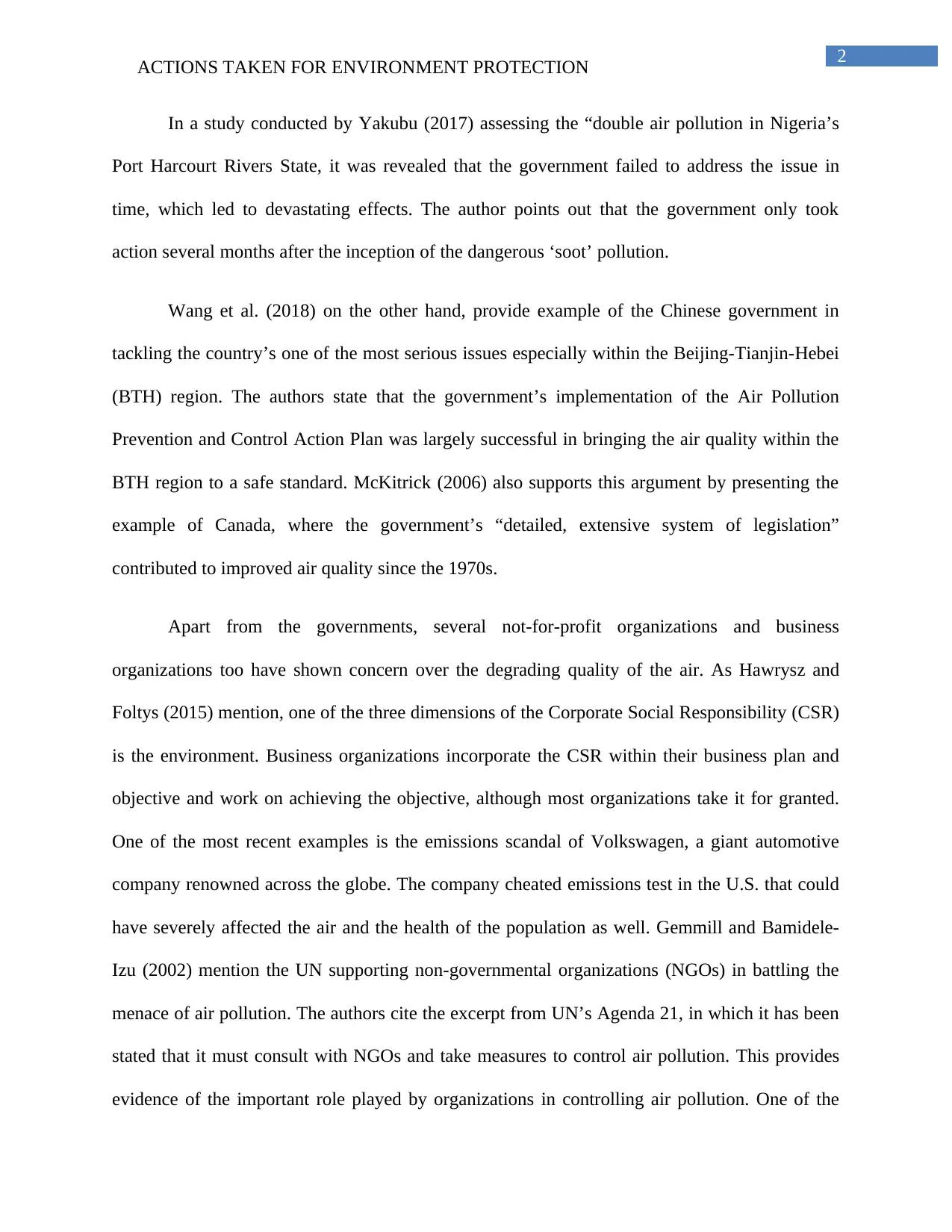
2
ACTIONS TAKEN FOR ENVIRONMENT PROTECTION
In a study conducted by Yakubu (2017) assessing the “double air pollution in Nigeria’s
Port Harcourt Rivers State, it was revealed that the government failed to address the issue in
time, which led to devastating effects. The author points out that the government only took
action several months after the inception of the dangerous ‘soot’ pollution.
Wang et al. (2018) on the other hand, provide example of the Chinese government in
tackling the country’s one of the most serious issues especially within the Beijing-Tianjin-Hebei
(BTH) region. The authors state that the government’s implementation of the Air Pollution
Prevention and Control Action Plan was largely successful in bringing the air quality within the
BTH region to a safe standard. McKitrick (2006) also supports this argument by presenting the
example of Canada, where the government’s “detailed, extensive system of legislation”
contributed to improved air quality since the 1970s.
Apart from the governments, several not-for-profit organizations and business
organizations too have shown concern over the degrading quality of the air. As Hawrysz and
Foltys (2015) mention, one of the three dimensions of the Corporate Social Responsibility (CSR)
is the environment. Business organizations incorporate the CSR within their business plan and
objective and work on achieving the objective, although most organizations take it for granted.
One of the most recent examples is the emissions scandal of Volkswagen, a giant automotive
company renowned across the globe. The company cheated emissions test in the U.S. that could
have severely affected the air and the health of the population as well. Gemmill and Bamidele-
Izu (2002) mention the UN supporting non-governmental organizations (NGOs) in battling the
menace of air pollution. The authors cite the excerpt from UN’s Agenda 21, in which it has been
stated that it must consult with NGOs and take measures to control air pollution. This provides
evidence of the important role played by organizations in controlling air pollution. One of the
ACTIONS TAKEN FOR ENVIRONMENT PROTECTION
In a study conducted by Yakubu (2017) assessing the “double air pollution in Nigeria’s
Port Harcourt Rivers State, it was revealed that the government failed to address the issue in
time, which led to devastating effects. The author points out that the government only took
action several months after the inception of the dangerous ‘soot’ pollution.
Wang et al. (2018) on the other hand, provide example of the Chinese government in
tackling the country’s one of the most serious issues especially within the Beijing-Tianjin-Hebei
(BTH) region. The authors state that the government’s implementation of the Air Pollution
Prevention and Control Action Plan was largely successful in bringing the air quality within the
BTH region to a safe standard. McKitrick (2006) also supports this argument by presenting the
example of Canada, where the government’s “detailed, extensive system of legislation”
contributed to improved air quality since the 1970s.
Apart from the governments, several not-for-profit organizations and business
organizations too have shown concern over the degrading quality of the air. As Hawrysz and
Foltys (2015) mention, one of the three dimensions of the Corporate Social Responsibility (CSR)
is the environment. Business organizations incorporate the CSR within their business plan and
objective and work on achieving the objective, although most organizations take it for granted.
One of the most recent examples is the emissions scandal of Volkswagen, a giant automotive
company renowned across the globe. The company cheated emissions test in the U.S. that could
have severely affected the air and the health of the population as well. Gemmill and Bamidele-
Izu (2002) mention the UN supporting non-governmental organizations (NGOs) in battling the
menace of air pollution. The authors cite the excerpt from UN’s Agenda 21, in which it has been
stated that it must consult with NGOs and take measures to control air pollution. This provides
evidence of the important role played by organizations in controlling air pollution. One of the
⊘ This is a preview!⊘
Do you want full access?
Subscribe today to unlock all pages.

Trusted by 1+ million students worldwide
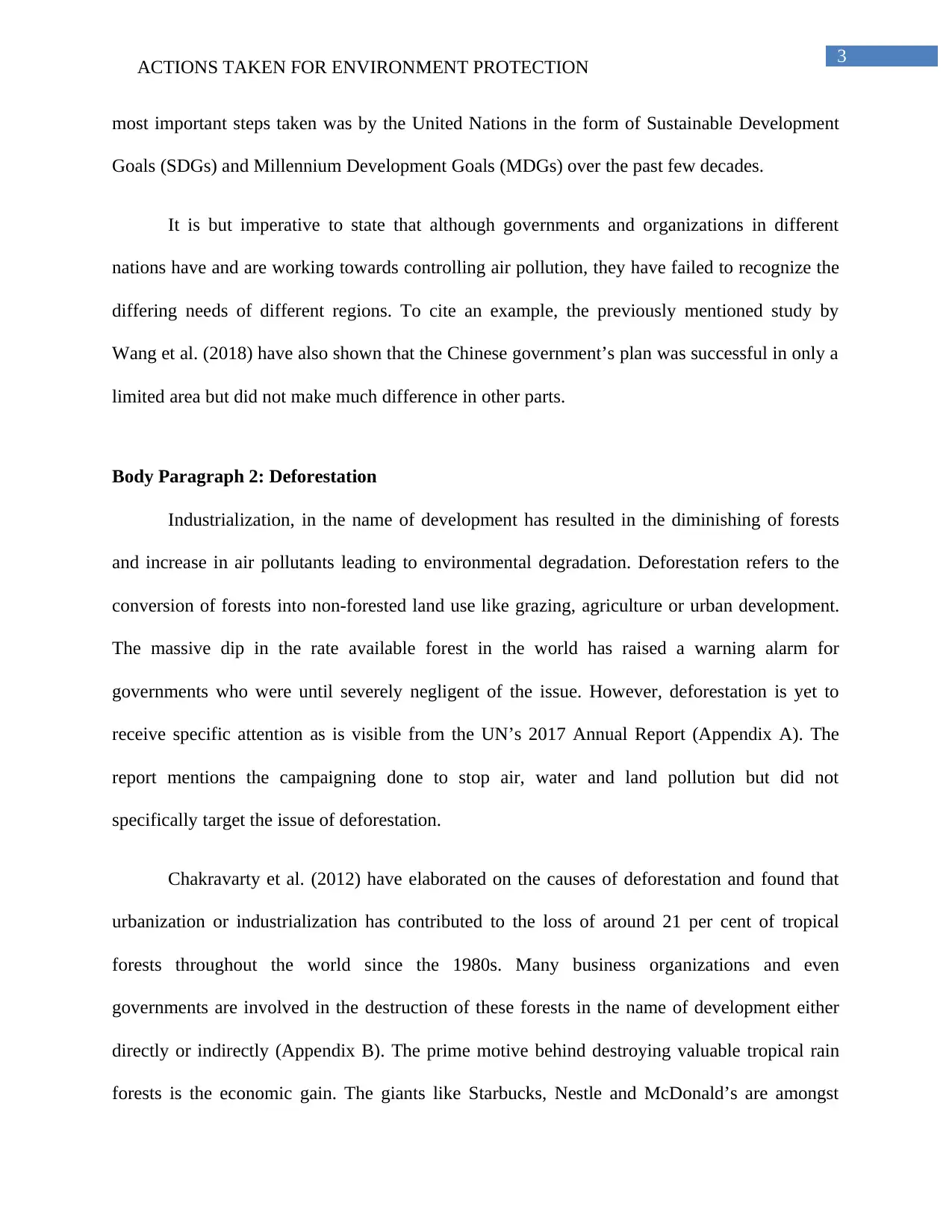
3
ACTIONS TAKEN FOR ENVIRONMENT PROTECTION
most important steps taken was by the United Nations in the form of Sustainable Development
Goals (SDGs) and Millennium Development Goals (MDGs) over the past few decades.
It is but imperative to state that although governments and organizations in different
nations have and are working towards controlling air pollution, they have failed to recognize the
differing needs of different regions. To cite an example, the previously mentioned study by
Wang et al. (2018) have also shown that the Chinese government’s plan was successful in only a
limited area but did not make much difference in other parts.
Body Paragraph 2: Deforestation
Industrialization, in the name of development has resulted in the diminishing of forests
and increase in air pollutants leading to environmental degradation. Deforestation refers to the
conversion of forests into non-forested land use like grazing, agriculture or urban development.
The massive dip in the rate available forest in the world has raised a warning alarm for
governments who were until severely negligent of the issue. However, deforestation is yet to
receive specific attention as is visible from the UN’s 2017 Annual Report (Appendix A). The
report mentions the campaigning done to stop air, water and land pollution but did not
specifically target the issue of deforestation.
Chakravarty et al. (2012) have elaborated on the causes of deforestation and found that
urbanization or industrialization has contributed to the loss of around 21 per cent of tropical
forests throughout the world since the 1980s. Many business organizations and even
governments are involved in the destruction of these forests in the name of development either
directly or indirectly (Appendix B). The prime motive behind destroying valuable tropical rain
forests is the economic gain. The giants like Starbucks, Nestle and McDonald’s are amongst
ACTIONS TAKEN FOR ENVIRONMENT PROTECTION
most important steps taken was by the United Nations in the form of Sustainable Development
Goals (SDGs) and Millennium Development Goals (MDGs) over the past few decades.
It is but imperative to state that although governments and organizations in different
nations have and are working towards controlling air pollution, they have failed to recognize the
differing needs of different regions. To cite an example, the previously mentioned study by
Wang et al. (2018) have also shown that the Chinese government’s plan was successful in only a
limited area but did not make much difference in other parts.
Body Paragraph 2: Deforestation
Industrialization, in the name of development has resulted in the diminishing of forests
and increase in air pollutants leading to environmental degradation. Deforestation refers to the
conversion of forests into non-forested land use like grazing, agriculture or urban development.
The massive dip in the rate available forest in the world has raised a warning alarm for
governments who were until severely negligent of the issue. However, deforestation is yet to
receive specific attention as is visible from the UN’s 2017 Annual Report (Appendix A). The
report mentions the campaigning done to stop air, water and land pollution but did not
specifically target the issue of deforestation.
Chakravarty et al. (2012) have elaborated on the causes of deforestation and found that
urbanization or industrialization has contributed to the loss of around 21 per cent of tropical
forests throughout the world since the 1980s. Many business organizations and even
governments are involved in the destruction of these forests in the name of development either
directly or indirectly (Appendix B). The prime motive behind destroying valuable tropical rain
forests is the economic gain. The giants like Starbucks, Nestle and McDonald’s are amongst
Paraphrase This Document
Need a fresh take? Get an instant paraphrase of this document with our AI Paraphraser
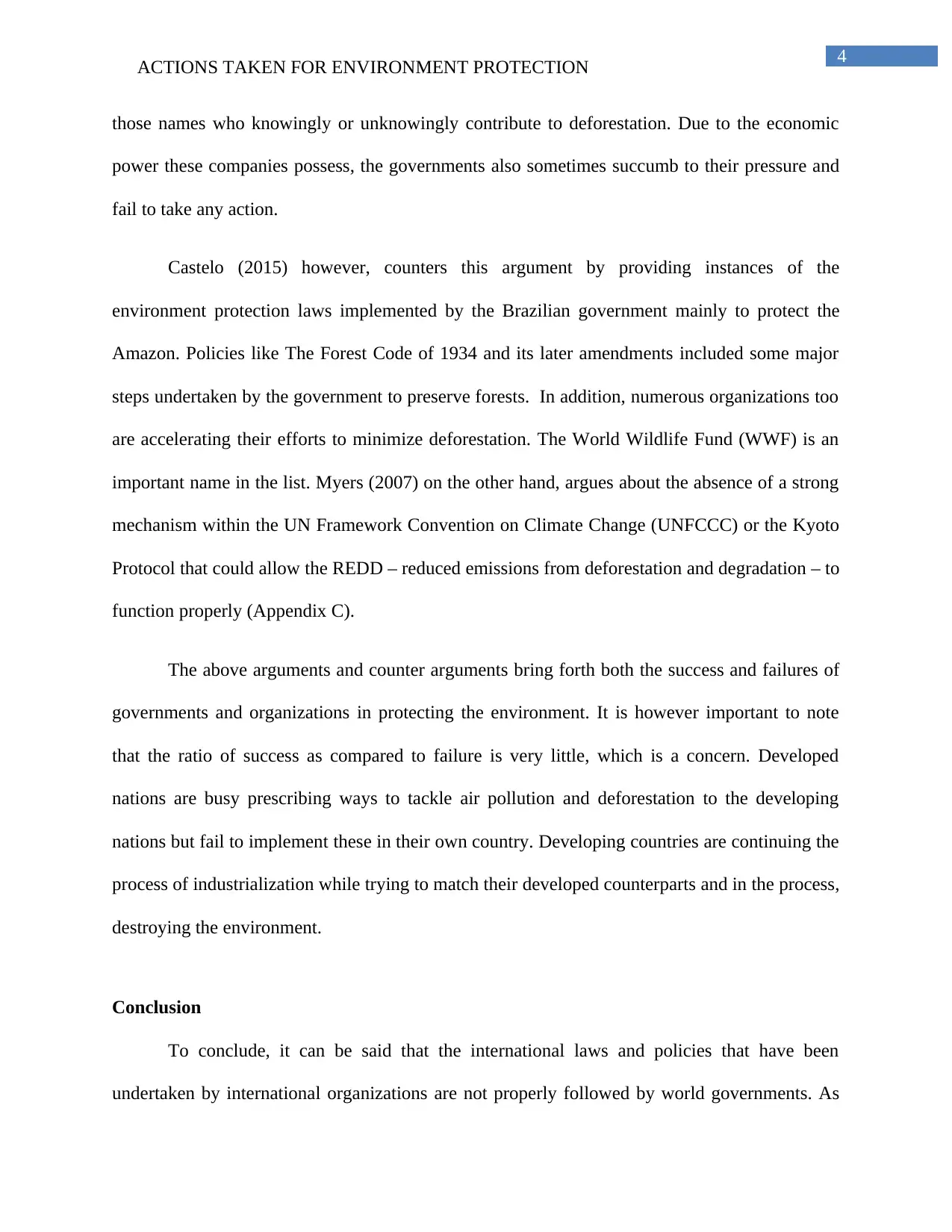
4
ACTIONS TAKEN FOR ENVIRONMENT PROTECTION
those names who knowingly or unknowingly contribute to deforestation. Due to the economic
power these companies possess, the governments also sometimes succumb to their pressure and
fail to take any action.
Castelo (2015) however, counters this argument by providing instances of the
environment protection laws implemented by the Brazilian government mainly to protect the
Amazon. Policies like The Forest Code of 1934 and its later amendments included some major
steps undertaken by the government to preserve forests. In addition, numerous organizations too
are accelerating their efforts to minimize deforestation. The World Wildlife Fund (WWF) is an
important name in the list. Myers (2007) on the other hand, argues about the absence of a strong
mechanism within the UN Framework Convention on Climate Change (UNFCCC) or the Kyoto
Protocol that could allow the REDD – reduced emissions from deforestation and degradation – to
function properly (Appendix C).
The above arguments and counter arguments bring forth both the success and failures of
governments and organizations in protecting the environment. It is however important to note
that the ratio of success as compared to failure is very little, which is a concern. Developed
nations are busy prescribing ways to tackle air pollution and deforestation to the developing
nations but fail to implement these in their own country. Developing countries are continuing the
process of industrialization while trying to match their developed counterparts and in the process,
destroying the environment.
Conclusion
To conclude, it can be said that the international laws and policies that have been
undertaken by international organizations are not properly followed by world governments. As
ACTIONS TAKEN FOR ENVIRONMENT PROTECTION
those names who knowingly or unknowingly contribute to deforestation. Due to the economic
power these companies possess, the governments also sometimes succumb to their pressure and
fail to take any action.
Castelo (2015) however, counters this argument by providing instances of the
environment protection laws implemented by the Brazilian government mainly to protect the
Amazon. Policies like The Forest Code of 1934 and its later amendments included some major
steps undertaken by the government to preserve forests. In addition, numerous organizations too
are accelerating their efforts to minimize deforestation. The World Wildlife Fund (WWF) is an
important name in the list. Myers (2007) on the other hand, argues about the absence of a strong
mechanism within the UN Framework Convention on Climate Change (UNFCCC) or the Kyoto
Protocol that could allow the REDD – reduced emissions from deforestation and degradation – to
function properly (Appendix C).
The above arguments and counter arguments bring forth both the success and failures of
governments and organizations in protecting the environment. It is however important to note
that the ratio of success as compared to failure is very little, which is a concern. Developed
nations are busy prescribing ways to tackle air pollution and deforestation to the developing
nations but fail to implement these in their own country. Developing countries are continuing the
process of industrialization while trying to match their developed counterparts and in the process,
destroying the environment.
Conclusion
To conclude, it can be said that the international laws and policies that have been
undertaken by international organizations are not properly followed by world governments. As
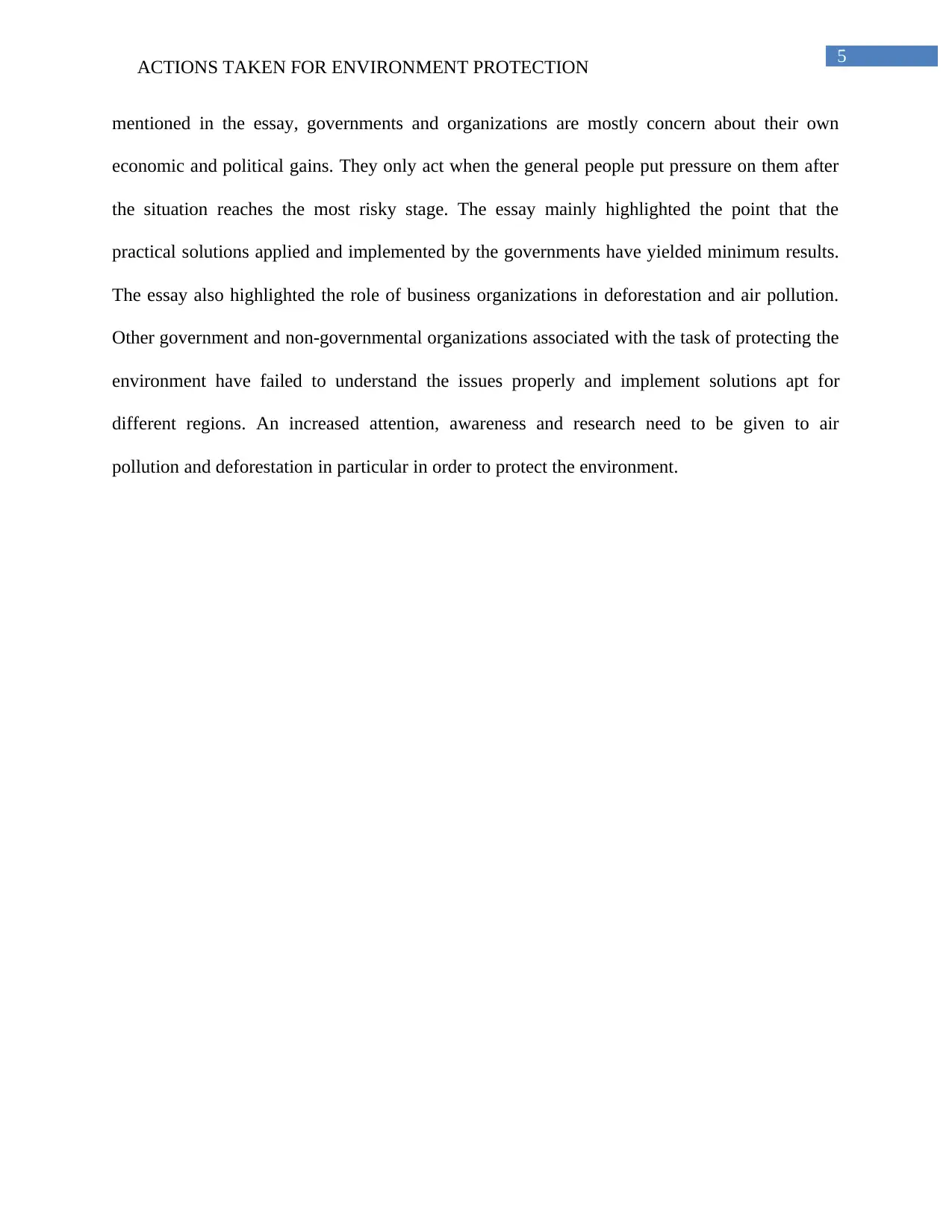
5
ACTIONS TAKEN FOR ENVIRONMENT PROTECTION
mentioned in the essay, governments and organizations are mostly concern about their own
economic and political gains. They only act when the general people put pressure on them after
the situation reaches the most risky stage. The essay mainly highlighted the point that the
practical solutions applied and implemented by the governments have yielded minimum results.
The essay also highlighted the role of business organizations in deforestation and air pollution.
Other government and non-governmental organizations associated with the task of protecting the
environment have failed to understand the issues properly and implement solutions apt for
different regions. An increased attention, awareness and research need to be given to air
pollution and deforestation in particular in order to protect the environment.
ACTIONS TAKEN FOR ENVIRONMENT PROTECTION
mentioned in the essay, governments and organizations are mostly concern about their own
economic and political gains. They only act when the general people put pressure on them after
the situation reaches the most risky stage. The essay mainly highlighted the point that the
practical solutions applied and implemented by the governments have yielded minimum results.
The essay also highlighted the role of business organizations in deforestation and air pollution.
Other government and non-governmental organizations associated with the task of protecting the
environment have failed to understand the issues properly and implement solutions apt for
different regions. An increased attention, awareness and research need to be given to air
pollution and deforestation in particular in order to protect the environment.
⊘ This is a preview!⊘
Do you want full access?
Subscribe today to unlock all pages.

Trusted by 1+ million students worldwide
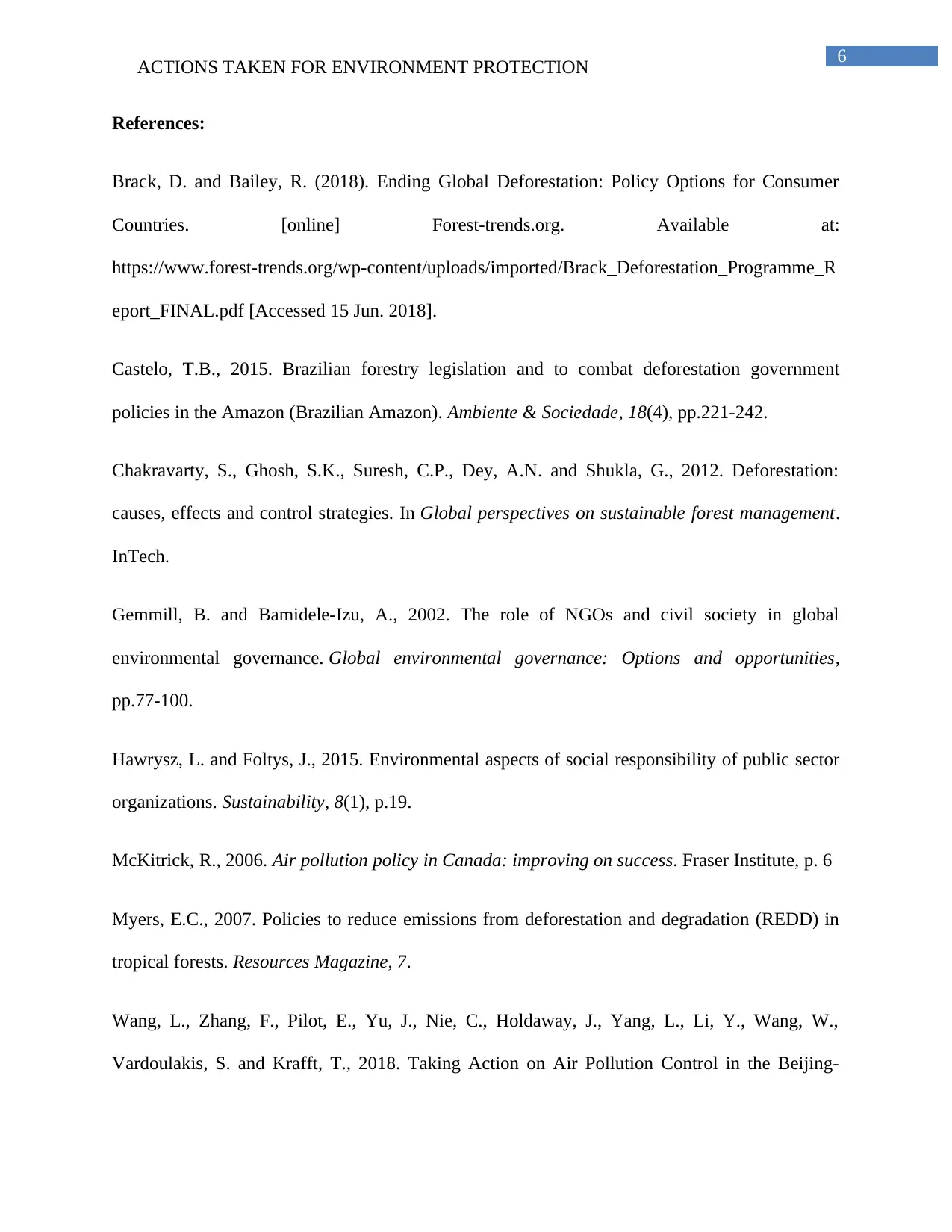
6
ACTIONS TAKEN FOR ENVIRONMENT PROTECTION
References:
Brack, D. and Bailey, R. (2018). Ending Global Deforestation: Policy Options for Consumer
Countries. [online] Forest-trends.org. Available at:
https://www.forest-trends.org/wp-content/uploads/imported/Brack_Deforestation_Programme_R
eport_FINAL.pdf [Accessed 15 Jun. 2018].
Castelo, T.B., 2015. Brazilian forestry legislation and to combat deforestation government
policies in the Amazon (Brazilian Amazon). Ambiente & Sociedade, 18(4), pp.221-242.
Chakravarty, S., Ghosh, S.K., Suresh, C.P., Dey, A.N. and Shukla, G., 2012. Deforestation:
causes, effects and control strategies. In Global perspectives on sustainable forest management.
InTech.
Gemmill, B. and Bamidele-Izu, A., 2002. The role of NGOs and civil society in global
environmental governance. Global environmental governance: Options and opportunities,
pp.77-100.
Hawrysz, L. and Foltys, J., 2015. Environmental aspects of social responsibility of public sector
organizations. Sustainability, 8(1), p.19.
McKitrick, R., 2006. Air pollution policy in Canada: improving on success. Fraser Institute, p. 6
Myers, E.C., 2007. Policies to reduce emissions from deforestation and degradation (REDD) in
tropical forests. Resources Magazine, 7.
Wang, L., Zhang, F., Pilot, E., Yu, J., Nie, C., Holdaway, J., Yang, L., Li, Y., Wang, W.,
Vardoulakis, S. and Krafft, T., 2018. Taking Action on Air Pollution Control in the Beijing-
ACTIONS TAKEN FOR ENVIRONMENT PROTECTION
References:
Brack, D. and Bailey, R. (2018). Ending Global Deforestation: Policy Options for Consumer
Countries. [online] Forest-trends.org. Available at:
https://www.forest-trends.org/wp-content/uploads/imported/Brack_Deforestation_Programme_R
eport_FINAL.pdf [Accessed 15 Jun. 2018].
Castelo, T.B., 2015. Brazilian forestry legislation and to combat deforestation government
policies in the Amazon (Brazilian Amazon). Ambiente & Sociedade, 18(4), pp.221-242.
Chakravarty, S., Ghosh, S.K., Suresh, C.P., Dey, A.N. and Shukla, G., 2012. Deforestation:
causes, effects and control strategies. In Global perspectives on sustainable forest management.
InTech.
Gemmill, B. and Bamidele-Izu, A., 2002. The role of NGOs and civil society in global
environmental governance. Global environmental governance: Options and opportunities,
pp.77-100.
Hawrysz, L. and Foltys, J., 2015. Environmental aspects of social responsibility of public sector
organizations. Sustainability, 8(1), p.19.
McKitrick, R., 2006. Air pollution policy in Canada: improving on success. Fraser Institute, p. 6
Myers, E.C., 2007. Policies to reduce emissions from deforestation and degradation (REDD) in
tropical forests. Resources Magazine, 7.
Wang, L., Zhang, F., Pilot, E., Yu, J., Nie, C., Holdaway, J., Yang, L., Li, Y., Wang, W.,
Vardoulakis, S. and Krafft, T., 2018. Taking Action on Air Pollution Control in the Beijing-
Paraphrase This Document
Need a fresh take? Get an instant paraphrase of this document with our AI Paraphraser

7
ACTIONS TAKEN FOR ENVIRONMENT PROTECTION
Tianjin-Hebei (BTH) Region: Progress, Challenges and Opportunities. International journal of
environmental research and public health, 15(2), p.306.
Yakubu, O.H., 2017. Particle (Soot) Pollution in Port Harcourt Rivers State, Nigeria—Double
Air Pollution Burden? Understanding and Tackling Potential Environmental Public Health
Impacts. Environments, 5(1), p.2.
ACTIONS TAKEN FOR ENVIRONMENT PROTECTION
Tianjin-Hebei (BTH) Region: Progress, Challenges and Opportunities. International journal of
environmental research and public health, 15(2), p.306.
Yakubu, O.H., 2017. Particle (Soot) Pollution in Port Harcourt Rivers State, Nigeria—Double
Air Pollution Burden? Understanding and Tackling Potential Environmental Public Health
Impacts. Environments, 5(1), p.2.
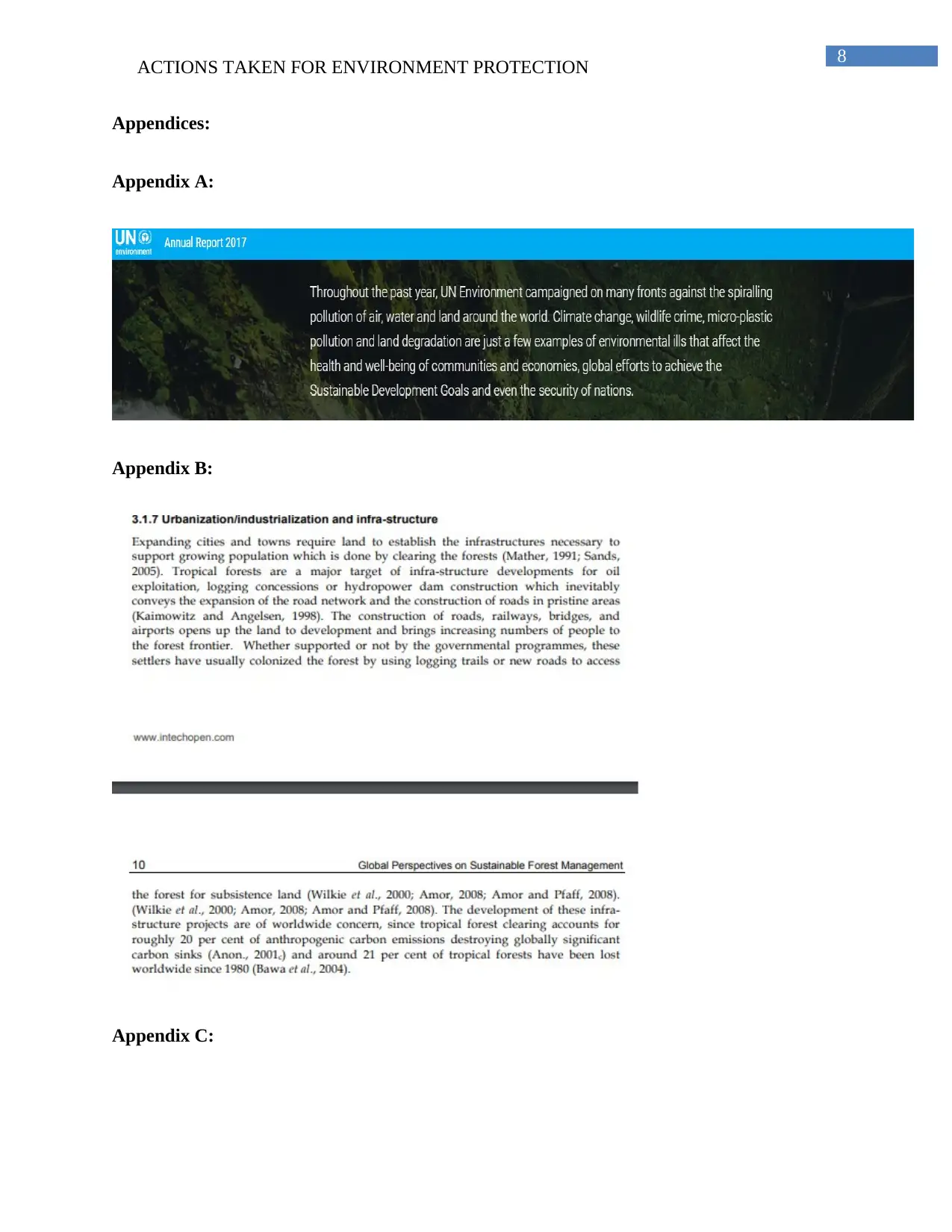
8
ACTIONS TAKEN FOR ENVIRONMENT PROTECTION
Appendices:
Appendix A:
Appendix B:
Appendix C:
ACTIONS TAKEN FOR ENVIRONMENT PROTECTION
Appendices:
Appendix A:
Appendix B:
Appendix C:
⊘ This is a preview!⊘
Do you want full access?
Subscribe today to unlock all pages.

Trusted by 1+ million students worldwide
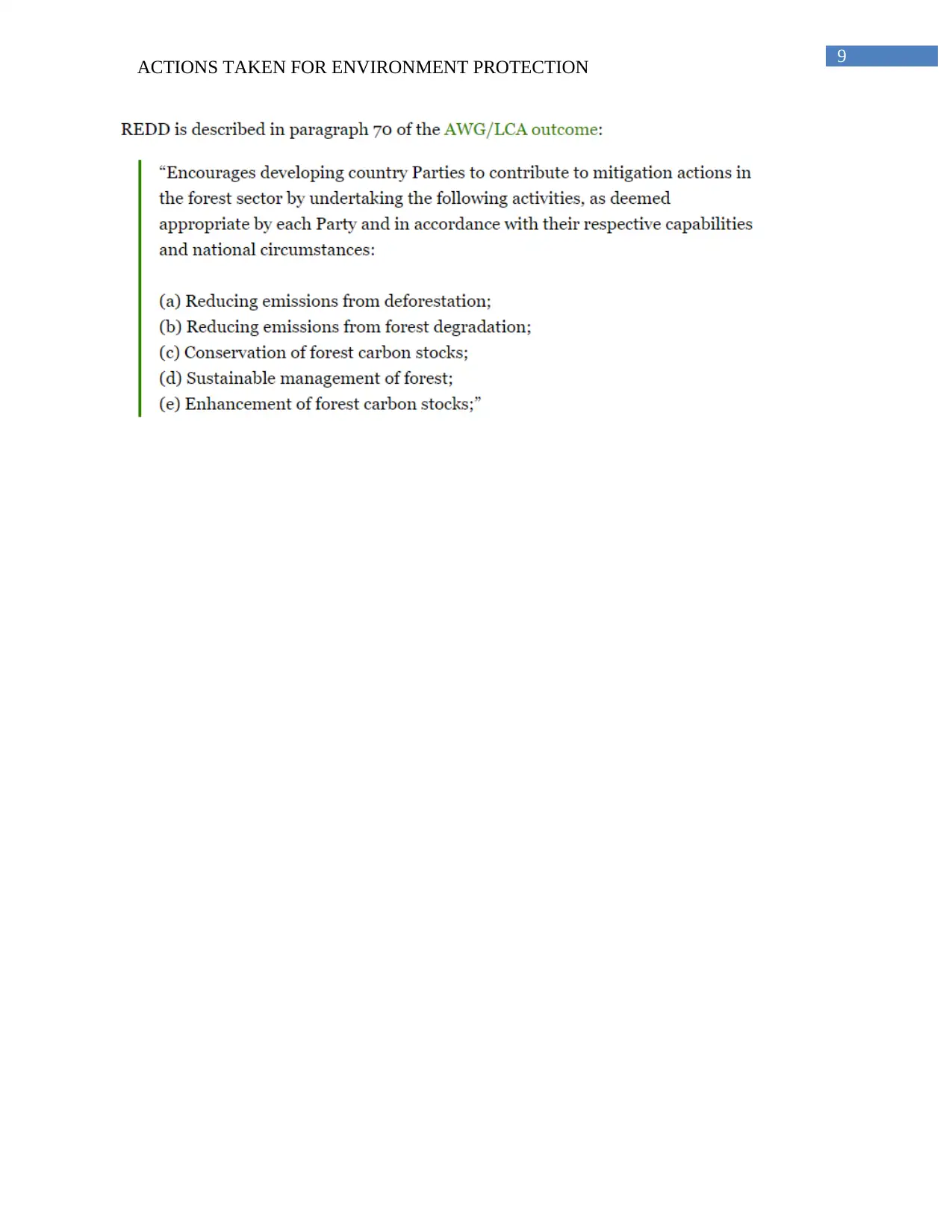
9
ACTIONS TAKEN FOR ENVIRONMENT PROTECTION
ACTIONS TAKEN FOR ENVIRONMENT PROTECTION
1 out of 10
Related Documents
Your All-in-One AI-Powered Toolkit for Academic Success.
+13062052269
info@desklib.com
Available 24*7 on WhatsApp / Email
![[object Object]](/_next/static/media/star-bottom.7253800d.svg)
Unlock your academic potential
Copyright © 2020–2025 A2Z Services. All Rights Reserved. Developed and managed by ZUCOL.





